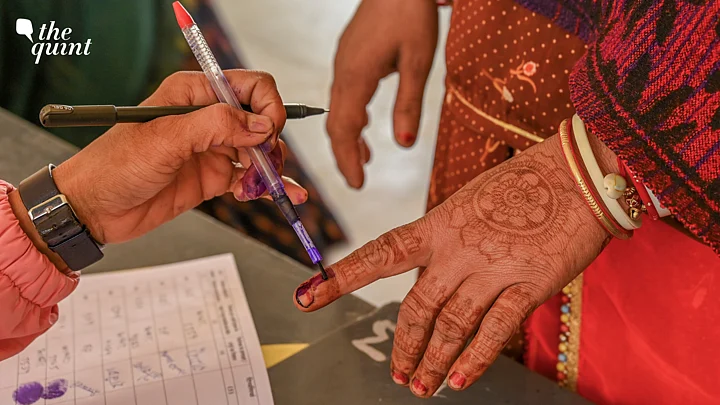Do welfare schemes targeted towards women change the way they vote during elections? If data from the exit polls of the five state Assemblies that went for voting in November is to be believed, then maybe yes.
Data from India Today’s Axis MyIndia poll predicts that:
In Madhya Pradesh, the number of women voting for the Bharatiya Janata Party goes as high as 50 percent. Only 40 percent women, on the other hand, voted for the Congress.
In Chhattisgarh, 43 percent women have voted for the BJP and 41 percent women have voted for the incumbent Congress party.
From the numbers that have come out, only in Rajasthan does Congress have a higher number of women voting for the party. 44 percent women have voted for the Congress, while 40 percent women have voted for the BJP.
Apart from Madhya Pradesh, where 50 percent women and 44 percent men voted for the BJP, according to the exit poll, there's not much of a difference between the predicted vote shares.
In Chhattisgarh, the net difference between the vote shares of men and women is four percent for the BJP and two percent for the Congress. The predictions for Rajasthan are vice-versa.
So, what could be the reasons behind this predicted vote share?
Why It Matters How Women Vote
Political parties have been wooing women voters during elections because in the past few polls, they have been kingmakers.
Akshi Chawla, curator of WomenLead, a platform that tracks the representation of women in politics globally, says:
“Targeting women voters during elections is becoming increasingly common, both at the state and national level, and this is precisely a numbers game. Earlier, there would be a gender gap in voter turnout, but now that gap has not only closed, but in some states, more women are now coming out to vote than men.”
In the 2018 Assembly elections in Madhya Pradesh, 74 percent women voted across the state.
In the same year in Rajasthan, 74.66 percent women went to the polling booths to vote, outshining men in the state. The women’s voter turnout was higher than the state’s overall voting percentage as well, which was recorded at 74.21 percent.
Tara Krishnaswamy, political commentator and co-founder of Political Shakti, tells The Quint,
“Whether the survey data is accurate or not, we’ll only know when the election results actually come in. But based on the way women have voted historically, they certainly look at delivered benefits that could go beyond just welfare schemes – safety and security, a more livable environment, and poverty alleviation for their families."
Krishnaswamy goes on to add, "Welfare schemes would be one aspect, but women vote based on what’s delivered to them rather than just promises. Both in MP and Rajasthan, we know the governments have been working on welfare. We will have to wait for the results to see how that has fared for them.”
What Krishnaswamy says, holds true. In the past one year, political parties in both MP and Rajasthan have aggressively campaigned and promised women's welfare in their manifestos.
But It’s Too Soon To Say Anything…
But political commentators are also wary of these numbers as of now. For one, Chawla thinks that the difference in numbers between male and female voters is not “significant.”
“We don’t have any measurement to understand if it is welfare schemes that are moving the needle for women. From the data, we see the gap between men and women’s voting patterns to be miniscule. A 1-2 percentage gap may not always be statistically significant. And we’ve seen that women do not vote as a block.”Akshi Chawla
Chawla explains that such a small net difference between men's and women's vote shares, specifically in Chhattisgarh and Rajasthan, may not necessarily be statistically significant, so until the election results come in on 3 December, nothing can be said for sure.
Krishnaswamy agrees. She tells The Quint that historically, in many states, women have voted beyond caste, religion, intersectional considerations– but that has again always been when they have been delivered benefits.
“But this doesn’t happen in every election because demographic and intersectional issues do matter,” she says.
Psephologist and co-director of Lokniti Sanjay Kumar, however, believes that that might not be the case across demographics. In a 2022 interview with The Quint, Kumar has said,
“When it comes to unemployment, when it comes to price rises, we noticed that there is some differential pattern. Unemployment, price rise, the day-to-day necessities – for these, the concern among women is much higher."
However, as Chawla says, more research needs to be done on how women are voting, what schemes or aspirations are helping them decide their favoured candidates and parties, and how to bridge the gap on what women need and what political parties think women need.
"A lot of this data can come from surveys and reporting, but we need more of it for a better understanding."Akshi Chawla to The Quint
(At The Quint, we question everything. Play an active role in shaping our journalism by becoming a member today.)
